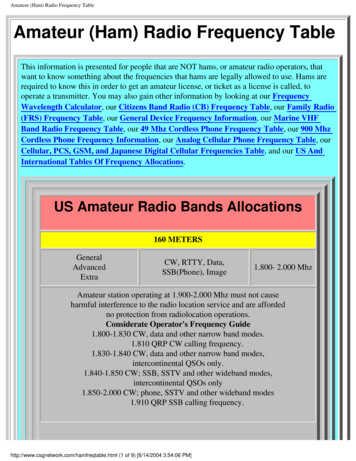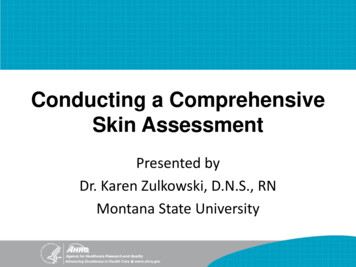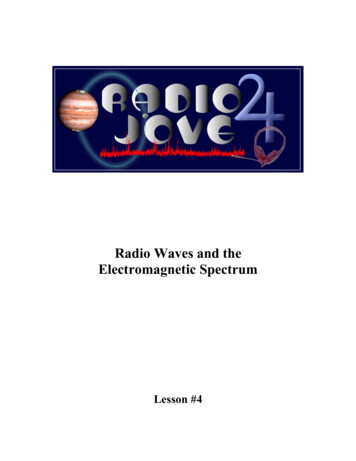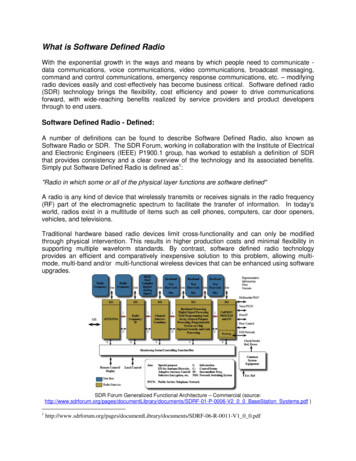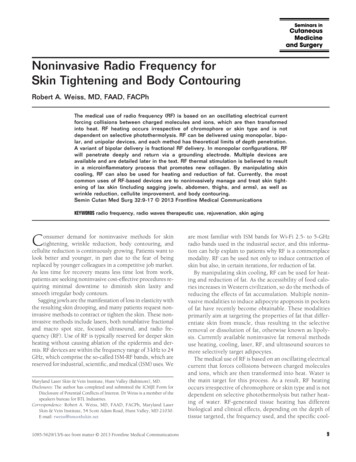
Transcription
Noninvasive Radio Frequency forSkin Tightening and Body ContouringRobert A. Weiss, MD, FAAD, FACPhThe medical use of radio frequency (RF) is based on an oscillating electrical currentforcing collisions between charged molecules and ions, which are then transformedinto heat. RF heating occurs irrespective of chromophore or skin type and is notdependent on selective photothermolysis. RF can be delivered using monopolar, bipolar, and unipolar devices, and each method has theoretical limits of depth penetration.A variant of bipolar delivery is fractional RF delivery. In monopolar configurations, RFwill penetrate deeply and return via a grounding electrode. Multiple devices areavailable and are detailed later in the text. RF thermal stimulation is believed to resultin a microinflammatory process that promotes new collagen. By manipulating skincooling, RF can also be used for heating and reduction of fat. Currently, the mostcommon uses of RF-based devices are to noninvasively manage and treat skin tightening of lax skin (including sagging jowls, abdomen, thighs, and arms), as well aswrinkle reduction, cellulite improvement, and body contouring.Semin Cutan Med Surg 32:9-17 2013 Frontline Medical CommunicationsKEYWORDS radio frequency, radio waves therapeutic use, rejuvenation, skin agingConsumer demand for noninvasive methods for skintightening, wrinkle reduction, body contouring, andcellulite reduction is continuously growing. Patients want tolook better and younger, in part due to the fear of beingreplaced by younger colleagues in a competitive job market.As less time for recovery means less time lost from work,patients are seeking noninvasive cost-effective procedures requiring minimal downtime to diminish skin laxity andsmooth irregular body contours.Sagging jowls are the manifestation of loss in elasticity withthe resulting skin drooping, and many patients request noninvasive methods to contract or tighten the skin. These noninvasive methods include lasers, both nonablative fractionaland macro spot size, focused ultrasound, and radio frequency (RF). Use of RF is typically reserved for deeper skinheating without causing ablation of the epidermis and dermis. RF devices are within the frequency range of 3 kHz to 24GHz, which comprise the so-called ISM-RF bands, which arereserved for industrial, scientific, and medical (ISM) uses. WeMaryland Laser Skin & Vein Institute, Hunt Valley (Baltimore), MD.Disclosures: The author has completed and submitted the ICMJE Form forDisclosure of Potential Conflicts of Interest. Dr Weiss is a member of thespeakers bureau for BTL Industries.Correspondence: Robert A. Weiss, MD, FAAD, FACPh, Maryland LaserSkin & Vein Institute, 54 Scott Adam Road, Hunt Valley, MD 21030.E-mail: rweiss@smoothskin.net1085-5629/13/ -see front matter 2013 Frontline Medical Communicationsare most familiar with ISM bands for Wi-Fi 2.5- to 5-GHzradio bands used in the industrial sector, and this information can help explain to patients why RF is a commonplacemodality. RF can be used not only to induce contraction ofskin but also, in certain iterations, for reduction of fat.By manipulating skin cooling, RF can be used for heating and reduction of fat. As the accessibility of food calories increases in Western civilization, so do the methods ofreducing the effects of fat accumulation. Multiple noninvasive modalities to induce adipocyte apoptosis in pocketsof fat have recently become obtainable. These modalitiesprimarily aim at targeting the properties of fat that differentiate skin from muscle, thus resulting in the selectiveremoval or dissolution of fat, otherwise known as lipolysis. Currently available noninvasive fat removal methodsuse heating, cooling, laser, RF, and ultrasound sources tomore selectively target adipocytes.The medical use of RF is based on an oscillating electricalcurrent that forces collisions between charged moleculesand ions, which are then transformed into heat. Water isthe main target for this process. As a result, RF heatingoccurs irrespective of chromophore or skin type and is notdependent on selective photothermolysis but rather heating of water. RF-generated tissue heating has differentbiological and clinical effects, depending on the depth oftissue targeted, the frequency used, and the specific cool9
R.A. Weiss10ing of the dermis and epidermis. The depth of penetrationof RF energy is inversely proportional to the frequency. Consequently, lower frequencies of RF are able to penetrate moredeeply. RF technology also has the ability to noninvasively andselectively heat large volumes of subcutaneous adipose tissue.By selecting the appropriate electric field, one can obtain greaterheating of fat or water.RF can be delivered using the monopolar, bipolar, andunipolar devices described later in the text. The dermis iscomposed of collagen, elastin, and ground substances. RFmediated thermal stimulation of this matrix results in animmediate, although temporary, change in the helical structure of collagen.1 It is also believed that RF thermal stimulation results in a microinflammatory stimulation of fibroblasts, which produces new collagen (neocollagenesis) andnew elastin (neoelastogenesis), as well as other substances toenhance dermal structure.2 RF thermal stimulation of adipose tissue is believed to result in a thermal-mediated stimulation of adipocyte metabolism and augmented activity oflipase-mediated enzymatic degradation of triglycerides intofree fatty acids and glycerol. Induction of apoptosis of fat cellsis another proposed mechanism.Methods of RF DeliveryMonopolarThe ISM bands were first established at the InternationalTelecommunications Conference of the International Telecommunication Union held in Atlantic City in 1947. Initialuse of RF for medicine included the pinpoint coagulation ofblood vessels during surgery. This was the first use of monopolar RF, requiring the patient to have a grounding plate incontact with the skin. RF-induced heat ablation has beenapplied to other fields of dermatology, including soft-tissue(basal cell carcinoma) ablation, endovenous ablation of thesaphenous system varicosities, and the treatment of vascularabnormalities. Currently, the most common uses of RF-baseddevices are to noninvasively manage and treat skin tighteningof lax skin, wrinkle reduction, cellulite improvement, andbody-contouring enhancement by influencing adipocytes.There are many devices on the market that have wide-rangingmethods of RF delivery (Table 1). RF devices may be monopolar, meaning the patient is grounded and the RF is delivered through the skin, into the body, and ultimately to thegrounding electrode. Typically, RF travels through structureswith the highest water content with the greatest resistance offat.These monopolar devices may be delivered in a stampedmode in which a short cycle of 1-2 seconds is delivered whilethe handpiece is held in place (Thermage Solta Medical, Hayward, CA). Alternatively, monopolar RF may be delivered byeither continuous movement or dynamically, where RF isdelivered in a continuous pulse with constant rotation of thehandpiece (Exilis, BTL, Prague, Czech Republic). In the staticstamped method, a single pulse is delivered; the handpiece isthen moved to an adjacent marked area and fired again. Thisis performed for hundreds of pulses until a premarked area istreated. Each pulse is measured for temperature while spraycooling is applied so the skin temperature does not exceed45 C. With dynamic monopolar RF, the handpiece is continuously moved, and specific areas of laxity can be targeted ina relatively short time to reach a final temperature. The surface temperature measurements are continuously monitored,and the measurement tool is often built into the handpiece.The dynamic devices are quicker and require more techniqueand skill; the stamped devices are more tedious and takelonger, but are easier to perform.BipolarWhen using the bipolar method of RF delivery, the RF travelsto and from the positive and negative poles, which are usuallybuilt into the handpiece. With a specific distance between theelectrodes, the depth of penetration and heating is predetermined by the spacing of the electrodes and typically confinedto within 1-4 mm of the skin surface. It is commonly statedthat the depth of penetration is half the distance between theelectrodes, but there is little evidence to support this assertion. Multiple variations of the bipolar RF concept include:1. Fractional or fractionated RF constructed of mini-bipolar electrodes (eMatrix,e2, Syneron/Candela)2. Bipolar-insulated needle electrodes mechanically inserted into the dermis (ePrime, Syneron/Candela)3. Bipolar RF combined with other modalities, includingdiode laser or IPL (Polaris, Syneron/Candela)4. Multiple bipolar electrodes at different distances apartfiring sequentially to achieve different depths (Endymed PRO, Endymed)UnipolarAnother form of delivery is unipolar, in which there is oneelectrode, no grounding pad, and a large field of RF emittedin an omnidirectional field around a single electrode. This isanalogous to a radio tower broadcasting signals in all directions. Some devices new to the market are now labeled to betripolar or multipolar but are variations of the 3 basic deliverymethods (ie, monopolar, bipolar, and unipolar). Other energy sources (eg, laser or IPL) can be combined with RF.Large arrays of technologies use RF to smooth and tightenskin and reduce fat. Each of these devices have unique namesand marketing associated with them, but there are individualadvantages and disadvantages (Table 1). The most commonuses of RF-based devices are to noninvasively manage andtreat skin tightening of lax skin, including sagging jowls,abdomen, thighs, and arms, as well as wrinkle reduction,cellulite improvement, and body contouring.RF DevicesThermage or ThermaCoolThe first device approved for RF skin contraction was theThermage (Solta Medical, Hayward, CA) monopolar RF device, which was cleared by the US Food and Drug Administration in 2002 for sale in the United States for general sur-
Radio frequency for skin tightening and body contouring11Table 1 RF Devices for Skin Tightening (Courtesy of BTL, Prague, CR)ProductManufacturerFrequencyOutput EnergyDelivery SystemFeaturesMonopolar DevicesExilisBTL3.4 MHzUp to 120W/90 WCPT ComfortablePulseTechnologyThermage Solta6.78 MHz400 WCuteraTruSculpt1 MHzEllmanPelleve4 MHzalternatingContact coolingMonopolar energy flow control, safetysystem, built-in thermometer, norisk of overheatingNew handpiece with TENS andvibrations to improve patient comfort.Pain nerval interceptors get confusedand busy (vibrations, cooling, heating)Levels4ⴖ handpieceHandpiece that reads out onceoptimal temperature is reached of43-45 C4 small handpieces: 7.5, 10,15, 20 mmSeveral handpieces for smaller areas.Can use unit as an electrocauteryunit alsoBipolar DevicesAccent EliteAlma40.68 MHzUp to 200 W1 handpiece bipolarVelaShape IISyneronNAIR - up to 35 W RFup to 50 WHandpiece w bipolar RF, IR,suctioneMatrixSyneronNA25 J/cm3NOApollo—TriPollarPollogen1 MHz50 W3 handpieces Large, med,smallReactionViora0.8, 1.7, 2.45MHzBody 50 W Face20 WSVC suction Vaccuum, cooling4 modes - 0.8, 1.7, 2.45 ⴙmultichannelV-touchViora?SVC suction Vaccuum, cooling3 handpc—0.8, 1.7, 2.45EndyMed PRO 3Deep 3 PolesEndyMedMedical1 MHz65 W4 handpieces body contour,body tight, facial tightening,fractional3 deep RF, skin tightening HP, bodycontouring HP, facial tighteningHP, fractional skin resurfacing HPVenus Concept - 8Circular PolesVenus FreezeRF: 1 MHz, Mag:15 HzRF: up to 150-W Magflux: 15 GaussLarge handpiece 8 poles 5 mmapart, dual mode ⴝ bipolar ⴙmagnetic fieldMultipolar RF and magnetic pulseTiteFxInvasix1 MHz60 WBi–RF ⴙ vaccuumBipolar w suction real-time epidermaltemperature monitorgical use. In 2004, clearance for periocular wrinkles wasobtained. The initial indication that was promoted was treatment of the forehead for eyebrow elevation. Soon after, dermatologists were testing the device for treatment of saggingjowls and skin tightening in other body areas, such as theabdomen and thighs. The US Food and Drug Administrationcleared Thermage for body contouring in 2006. Larger handpieces to cover larger areas were also introduced (Fig. 1).There are 3 components to the ThermaCool device: (1) theRF generator, (2) the handheld tip with a thin membrane,and (3) a cryogen unit. To deliver cooling, other units usePeltier cooling. Sensors in the thin membrane tip measuretemperature and tissue contact. The membrane electrode isdesigned to disperse energy uniformly across the skin surfacein a process termed capacitive coupling, which creates a zoneof increased temperature at depths of 3-6 mm.3 The depth ofheating depends on the size and geometry of the treatmenttip.4 Theoretically, the device heats the dermis from 65 to75 C, the temperature at which collagen denatures, whereascooling allows epidermal temperatures between 35 and45 C. Zelickson and colleagues evaluated the effects of RF(ThermaCool) on 2 samples of human abdominal skintreated with energy ranging from 95 to 181 J.1 The treatmenteffect was evaluated using light and electron microscopy ofpunch biopsies taken immediately and up to 8 weeks aftertreatment. Immediately after treatment, a mild perivascularand perifollicular infiltrate was observed. At 0, 3, and 8 weeksafter treatment, electron microscopy revealed collagen fibrilswith greater diameter (shortening of collagen fibers) compared with collagen fibers evaluated pretreatment, up to 5mm deep in the skin.5The most recent model, the ThermaCool NXT, has incorporated additional features with several tips and handpieces.These include tips for the body and eye and a handpiece forcellulite. A new Comfort Plus Technology tip is also available,which incorporates massage with RF energy delivery, increasing the speed of the procedure yet making it more comfortable by blocking pain using vibration.Some studies have analyzed the use of RF devices on subcutaneous fat and circumferential reduction in the size of
R.A. Weiss12Figure 1 (A) Large (3 cm) vs small (1 cm) handpieces for ThermaCool monopolar device (Solta, Hayward, CA). Usingthe larger 3-cm handpiece, it is possible to treat larger areas like the abdomen. (B) Clinical result of skin tightening onthe abdomen using ThermaCool device. Seen at 2 weeks after one treatment.treated areas. A summary of studies is shown in Table 2. Aninteresting study used the ThermalCool TC (Solta Medical,Inc, Hayward, CA) device with the Thermage Multiplex Tipto evaluate its effect on abdominal skin laxity and waist circumference.13 Twelve subjects were treated in this study, andresults demonstrated an average decrease in waist circumference of 1.4 cm at the 1-month follow-up visit. Another studyusing a different monopolar RF device was able to demonstrate that adipocyte cell death occurred from thermal injuryand was evident starting at 9 days after treatment.14 Foamyhistiocytic and granulomatous infiltrates were observed aftercell death around the adipose tissue, but no increase in circulating lipid levels was seen.Jacobson et al9 treated 24 patients with laxity of the neck,nasolabial folds, marionette lines, and jawline using the ThermaCool system. Each patient received 1-3 monthly treatments that consisted of 2 passes on the forehead, 3 on thecheek, and 1 on the neck using 106-144 J. Seventeen of theTable 2 Studies Evaluating the Effects of Monopolar RFAuthorsFitzpatrick etal6Bassichis et al3Nahm et al7Type of StudyResultsMulticenter nonrandomizedblinded clinical trialNonrandomized nonblindedPeriorbital wrinkles improvement and brow elevation; 50% patientsatisfactionObjective improvement in brow elevation, but majority of patients donot appreciate improvementOne side of brow treated in 10 patients, objective elevation ontreated site in all 10Six patients with statistically significant increase in collagen I and III,and newly synthesized collagen, while elastin was decreasedSubjective improvement in lower face skin tighteningSubjective improvement for cheek laxity and submental laxityLargest patient experience in 600 patients, few adverse events, allshort-term, 85% patient satisfactionAbdominal skin collagen fibril contraction with tissue contraction andthermally mediated wounding, new collagen production seenEl-Domyati et al8Nonrandomized nonblindedsplit faceHistologic studyJacobson et al9Alster et al10Weiss et al11Nonrandomized nonblindedNonrandomized nonblindedRetrospective chart reviewZelickson et al1Electron microscopyAdapted with permission from Lolis et al.12
Radio frequency for skin tightening and body contouring24 patients showed improvement by 1 month after treatment, and results continued to improve 3 months after treatment. Transient burning pain was described by most of thepatients. Patients who underwent multiple treatments andpasses had greater results. Alster and Tanzi reported similarfindings with the ThermaCool system, with improvement inmoderate cheek laxity and nasolabial folds in 30 patientstreated with monopolar RF.10Weiss et al11 published a retrospective chart review to establish the rate and seriousness of side effects, as well aspatient satisfaction. More than 600 patients were treated using the ThermaCool device for mild laxity. Patients weretreated with multiple passes with fluences of 74-130 J/cm2using a 1-, 1.5-, or 3-cm2 tip. The most common side effectswere erythema and edema lasting 24 hours. Transient erythema resolved within 5-20 minutes, with 5% reportingerythema lasting up to 72 hours. The most significant sideeffects occurred with the original 1-cm2 tip and included 1case of superficial crusting that resolved in 1 week, 1 case ofa slight depression on the cheek that lasted for 3.5 months, 3cases of subcutaneous erythematous papules, and 3 cases ofneck tenderness lasting 1-4 weeks. The overall rate of unexpected adverse side effects with the first-generation devicewas 2.7%, but with subsequent generations and using themultiple-pass lower-energy treatment algorithm, no adverseeffects have been seen. Patient satisfaction was high at 90%.Monopolar RF has also been used to treat active cystic acneto inhibit sebaceous activity and promote dermal contouring.A study including 22 patients with moderate to severe activecystic acne reported improvement using stamped monopolarRF.15 Patients were treated in 1-3 sessions using 65-103J/cm2. A 75% reduction in active acne lesion count was seenin 92% of patients, and a 25%-50% reduction occurred in 9%of patients. Often a decrease in active lesions was accompanied by improvement of underlying scarring. These resultshave not been duplicated in other studies.Exilis DeviceThe Exilis (BTL, Prague, Czech Republic) is a novel RF dynamic monopolar device that combines focused monopolarRF delivery with a number of built-in safety features, including Peltier cooling (Fig. 2). The Exilis system delivers theenergy through 2 different hand applicators, one designed forthe face and one designed for the body. The goal of treatmentis to raise the surface temperature to 40-42 C for 4-5 minutesfor each region treated. When this temperature is reached,the patient feels a comfortably warm sensation. The handpiece is in continuous motion so the areas of skin with themost laxity can be specifically targeted. This has been termeddynamic monopolar RF. Additionally, Peltier cooling can beadjusted up or down to allow targeting of skin or subcutaneous tissue. For example, to drive heating more deeply, theskin is cooled and protected, allowing heat to reach into thesubcutaneous fat. Alternatively, to get maximum effect onskin laxity, cooling is turned off and heating of the skin occurs quickly, with minimal effect on subcutaneous fat.13For the body applicator, the skin temperature is monitoredand continuously displayed by an on-board infrared temperature sensor. When the device senses spikes in RF delivery,these spikes are automatically reduced. Constant monitoringof energy flow through tissue (impedance) detects tip contactwith skin. The device is equipped with an energy flow controlsystem, which automatically shuts off the device when the tipcontact and/or energy flow is disrupted and virtually eliminates the risks of burns. The energy flow control allows use ofhigh power (watts), which then leads to faster treatmenttimes while ensuring the greatest level of safety and comfort.This device also warns when RF is not being delivered.Experiments have shown that the increased temperature effect is seen as much as 2 cm below the skin with surfacecooling (Fig. 3). The primary advantage of this system is theability to target skin laxity or contour deformities. A precisedepth of penetration combined with the focused thermal effect due to advanced controlled cooling allows total body andfull face applications. A cohort of 30 patients who weretreated with the Exilis device on the jowls and neck for rhytidand laxity, as well as submental fat pad reduction, were followed for 6 months (Abstract accepted for presentation at theAmerican Society for Laser Medicine & Surgery’s 33rdASLMS Annual Conference; April 3-7, 2013; Boston, Massachusetts). The age range was 31-66 years. Additionally, 14 ofthe facial treatment patients were also treated for “jiggly” fatpads or loose skin on the arms between the shoulder andelbow. Circumference was measured mid-arm. The treatment target was fat pad and circumferential reduction and/ortightened skin. Patients were weighed and photographed before and after the study and were instructed to continue withtheir current lifestyle and not to change their nutrition, caloric intake, or physical activity routines.The treatment protocol is 10 minutes for a 20 25-cmarea, maintaining surface temperatures of 40-42 C, for 4treatments, with each treatment spaced at 7-10 days. Skintemperatures at the end of a treatment cycle were typically40 C, which rapidly dropped at the conclusion of the treatment. The patients were treated lying down comfortably,with the treatment area exposed. A water-based gel (face) ormineral oil (body) was applied to the treatment area beforethe onset of treatment. Baseline temperature before treatmentwas typically 32 C.The energy and treatment times were adjusted accordingto the area being treated. For the face, typically 30 W with100% duty cycle was used. For the body, 50-80 W with100% duty cycle was used. The RF applicator was applied tothe skin and maintained contact with the skin through each30-second treatment cycle. Circular motions or to-and-fromotions were used to keep the tip moving over the treatmentarea. The key is not to allow the RF applicator to stop movingbut to focus on areas of greatest concern. According to patientfeedback, the energy was adjusted up or down, as tolerated,to achieve a sustained surface temperature of 40-42 C with arapid slope up from baseline.In a recent study, 20 subjects had 4 circumferential treatment sessions with the Exilis device for the upper arm (Abstract accepted for presentation at the American Society for
R.A. Weiss14Figure 2 Device design for Exilis system (BTL, Prague, Czech Republic). (A) Unit with 2 handpieces. (B) Body treatmenthandpiece with temperature monitoring. (C) Facial treatment handpiece design. (D) Treatment with facial handpiece.Laser Medicine & Surgery’s 33rd ASLMS Annual Conference;April 3-7, 2013; Boston, Massachusetts). Treatment outcomewas not measured by images or circumference but by ultrasound thickness of the fat layer. Measurements were taken atprecise reproducible points on the arm. Authors reportedaverage posterior fat reduction for the arm of 0.5 cm vs 0.02for the untreated control arm. This was a statistically significant measurement of fat reduction by ultrasound fat layerthickness. Examples of clinical results for monopolar RF devices are shown in Fig. 4.Accent Unipolar DeviceThe Accent (Alma Lasers, Inc, Fort Lauderdale, FL) RF system isdesigned for continuous skin contact using 2 handpieces: theunipolar to deliver RF energy to the subcutaneous adipose tissuefor volumetric heating, and the bipolar to deliver RF energy tothe dermis for nonvolumetric heating. It uses both unipolar andbipolar RF and delivers different depths of RF current to theskin, theoretically bipolar for more superficial heating and unipolar for deeper dermal heating. Several clinical trials describeits use in reducing the appearance of cellulite and its effects ontissue tightening.16-18 In a randomized, blinded, split-designstudy, 10 individuals (aged 32-57 years) with a clinically observable excess of subcutaneous fat and cellulite (minimum grade 2out of 4) on the thighs received up to 6 unilateral treatments at2-week intervals with unipolar RF. All participants responded toa mean of 4.22 treatments, with a range of 3-6 treatments.Blinded evaluations of photographs using the cellulite gradingscale demonstrated an 11.25% mean improvement. The treatment was painless, and side effects included minimal to moder-
Radio frequency for skin tightening and body contouring15Figure 3 Monopolar RF depth can be controlled by cooling, depths of 2 cm can be achieved (Courtesy: BTL, Prague,Czech Republic).ate erythema, which resolved within 1-3 hours. No crusting,scarring, or dyspigmentation was observed. However, clinicallyvisible and quantified improvement did not achieve statisticalsignificance.Combination RF and Light (ELOS)The most widely used combination RF systems are those thatuse IPL, a diode laser, or infrared light. One system (AuroraSR, Syneron Medical, Ltd, Yokneam, Israel) uses IPL as itsoptical energy source, with wavelengths between 400 and980, 580 and 980, and 680 and 980 for different targets orchromophores. RF energies up to 25 J/cm3 can be generatedwith dermal penetration of 4 mm.19 Another system (PolarisWR, Syneron Medical, Ltd) is a combined 900-nm diodelaser with RF energy. Optical and RF energies are deliveredsimultaneously through the bipolar electrode tip. Optical energy fluences range from 10 to 50 J/cm2 and RF energies from10 to 100 J/cm3.12 Another ELOS device (VelaSmooth, Syneron Medical, Ltd) uses a combination of infrared light (7002000 nm), RF energy, and suction with mechanical massagefor the treatment of cellulite.20 All devices have been reportedto lead to moderate improvement.Bipolar RF Plus VacuumThe Aluma RF plus vacuum device (Aluma System Lumenis,Inc, Santa Clara, CA) is composed of an RF generator, ahandpiece, and a tip with 2 parallel electrodes. When thehandpiece with the tip is placed perpendicular to the surfaceof the skin, the system produces a vacuum, which suctions asmall area of skin.21 The skin becomes a U-shaped area withFigure 4 Clinical results with monopolar RF. (A) Before and immediately after third treatment for sagging. (B) Submental before and after 4 treatments. (C) Flanks (muffin top) before and after 3 treatments. Treatments using Exilis BTLmonopolar device.
R.A. Weiss16Figure 5 Fractional RF tip showing flow of current from microelectrodes. Flow is from positive to negative (Syneron/Candela).epidermis on both sides and dermis and connective tissue in themiddle. The design is to allow the energy emitted to reach themiddle and deep dermis. When 46 patients with 8 facial treatments, every 1-2 weeks, were evaluated, statistically significantimprovement in facial wrinkles was observed.22 A low incidenceof adverse events such as burning and crusting was reported.Another study reported clinical improvement in 30 patientstreated with 6-8 cycles of the vacuum plus RF system. Patientswere treated for multiple clinical conditions, including periocular and glabellar wrinkles, striae distensae, and acne scars. Byhistology, there was less collagen atrophy and greater interstitialedema of treated skin compared with untreated skin, whichshowed atrophic dermal collagen with elastotic changes.23Fractional RFFractional RF is another form of bipolar RF delivery withmini-electrodes. The concept is that RF is omnidirectional sothat dots of RF spread out from the point of contact in comparison with laser, in which the energy is attenuated in asharp fashion in interaction with tissue (Fig. 5). Fractional RFhas been used mainly for skin rejuvenation. Less than 1-mmthermal injuries are formed in a patterned fractional arraydirectly to the reticular dermis. The area directly in contactwith and below the array of microneedles or electrodes isselectively heated, whereas the areas between the targetedareas are left intact. A prospective multicenter study was conducted on 35 subjects who received 3 treatments on theirentire face with a fractional device (eMatrix RF, Syneron/Candela Medical, Ltd).24 Clinical improvement was assessed4 weeks after the last treatment using photographic analysis.Eighty-three percent of patients showed improvement inskin brightness, 87% in skin tightness, and 90% in smoothness and wrinkling. Subjects undergoing facial treatment hadminimal pain, no permanent side effects, and no significantdowntime. Investigators’ assessment for improvement in skintexture correlated with subjects’ evaluation and was 40%for approximately 50% of subjects. Eighty percent of thesubjects were satisfied with the results. Higher energy levelsand lower coverage rates produced better esthetic resultsalong with less pain.SafetyA recent advance has been a novel kind of RF energy deliverysystem that allows constant monitoring of the real-time localskin impedance changes during RF skin treatment (BTL Elite,BTL Aesthestics, Prague, Czech Republic). This ImpedanceCompensation system controls the energy supply while thecircuitry automatically compensates for impedance changes.Energy flow is controlled, and the computer automaticallykeeps the heating power on the optimal level even in areas ofhigher/lower impedance, allowing the operators’ use of highpower settings without compromising safety. The system enables th
Body 50 W Face 20 W SVC suction Vaccuum, cooling 4 modes - 0.8, 1.7, 2.45 multichannel V-touch Viora ? ? SVC suction Vaccuum, cooling 3 handpc—0.8, 1.7, 2.45 EndyMed PRO 3 Deep 3 Poles EndyMed Medical 1 MHz 65 W 4 handpieces body contour, body tight, facial tightening, fractional 3 deep RF, skin tightening HP, body contouring HP, facial .

